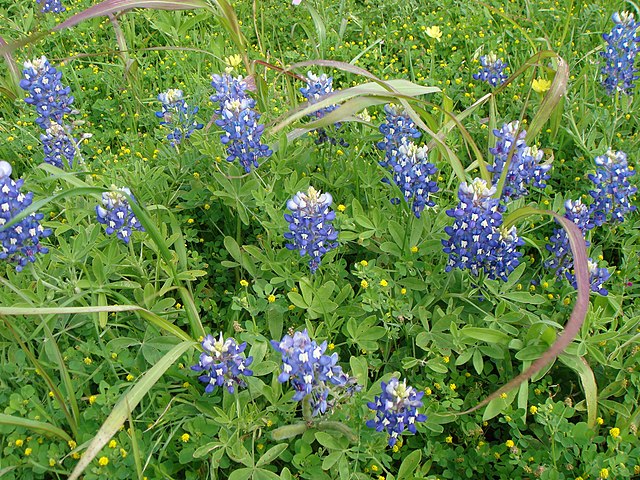Flowers add beauty and life to any landscape, bringing vibrant colors, diverse textures, and delightful fragrances to our gardens. Whether you’re new to gardening or an experienced horticulturist, understanding the different types of flowers and their unique characteristics can help you make the right choices for your garden. This guide will delve into the three main categories of flowering plants: annuals, biennials, and perennials. Each type brings its distinct advantages and maintenance needs to the garden, offering opportunities for creative expression and functional design.
This guide will explore the unique attributes and planting times of each type, providing you with the knowledge to cultivate a garden that thrives season after season.
Annuals
Annuals are plants that complete their life cycle in a single growing season, making them a popular choice for gardeners who want vibrant, seasonal color in their landscapes. These plants germinate, bloom, produce seeds, and die all within one year. Annuals like marigolds, petunias, and impatiens offer a burst of vivid flowers, bringing immediate impact to flower beds, containers, and borders. Their fast growth and prolific flowering make them excellent for filling in gaps in the garden or creating bold color statements.
There are two main types of Annuals, hardy annuals and half-hardy annuals. Hardy annuals are better at enduring seasonal changes or cold fronts. They can be planted earlier in the spring whereas half-hardy annuals need to wait until May or June in order to lower risk of weather killing the plants.
Examples of Annuals
Marigold (Tagetes spp.)
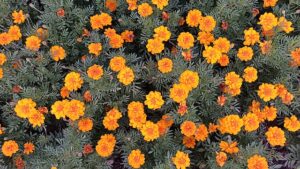
- Marigolds are known for their bright yellow, orange, and red flowers that repel pests. Their strong scent is believed to deter certain insects, making them a popular companion plant.
- They are a half-hardy species (do not do well with frost)
- Time to Plant: They grow best in full sun and bloom from late spring until the first frost.
Zinnia (Zinnia egelans)
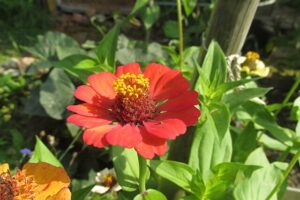
- Zinnias feature vibrant blooms in a range of colors, from pink and red to yellow and orange. They attract butterflies and pollinators, enhancing the garden’s ecosystem.
- Also a half-hardy annual
- Time to Plant: Plant zinnia seeds directly in the garden in spring after the last frost. They thrive in full sun and bloom from summer to fall.
Sunflower (Helianthus annuus)
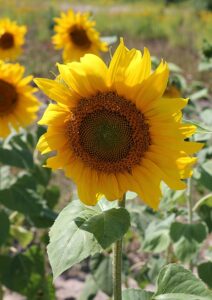
- Sunflowers are known for their tall stalks and large, sunny blooms. They can be grown for their ornamental value or harvested for seeds.
- Hardy species, able to handle frost.
- Time to Plant: Plant sunflower seeds in spring. Requires lots of sun and bloom from summer through early fall.
Texas Bluebonnet (Lupinus texensis)
(Our favorite pick)
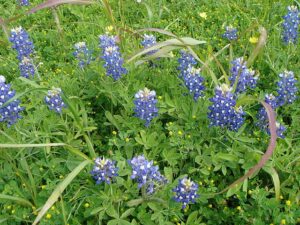
- Typically reaches 1 to 2 feet in height and has a rosette of green leaves at the base.
- Drought-tolerant once established and thrives in sunny locations.
- An iconic symbol of Texas
- Timing: The best time to plant bluebonnet seeds is in the fall, from September to November.
Biennials
Biennials are plants that complete their life cycle over two growing seasons. In the first year, they typically focus on vegetative growth, developing roots, leaves, and stems. During the second year, they shift their energy to reproduction, producing flowers, seeds, and fruits before dying. This unique life cycle sets them apart from annuals and perennials, offering a middle ground between the two. They are often used in landscape design for their ability to provide vibrant colors and textures across multiple seasons.
Black-eyed Susan (Rudbeckia hirta)
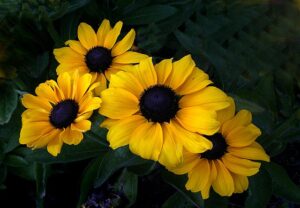
- Attributes: Known for their bright yellow petals and dark centers, they attract butterflies and are drought-tolerant once established.
- Planting Time: Sow seeds outdoors in late summer or early fall for spring blooming.
Foxglove (Digitalis purpurea)
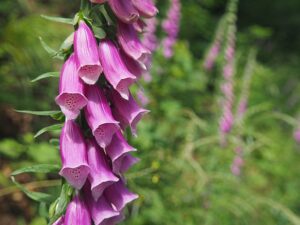
- Attributes: Tall spikes of tubular flowers in shades of pink, white, and purple. Known for their striking beauty and medicinal properties, though the plant is toxic if ingested.
- Planting Time: Plant seeds in late spring or early summer, and they will flower in their second year.
Hollyhock (Alcea rosea)
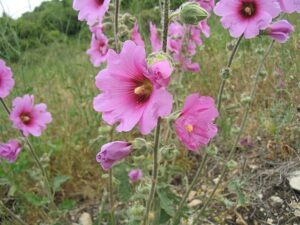
- Attributes: Towering spires with large, saucer-shaped flowers in a variety of colors, from pink and red to white and yellow. They create a dramatic vertical accent in gardens.
- Planting Time: Sow seeds in late spring to early summer, and they will bloom the following summer.
Carolina Larkspur (Delphinium carolinianum)

- Attributes: Features delicate, spurred flowers in blue or purple, often growing in clusters. A native Texas wildflower, it thrives in sunny areas and tolerates dry conditions.
- Planting Time: Sow seeds directly outdoors in the fall for blooms in late spring to early summer the next year.
These biennials thrive in Texas climates and add distinctive vertical interest to gardens with their towering flower spikes and colorful blooms.
Perennials
Perennials are plants that live for more than two years, offering gardeners a lasting foundation for their landscape. Unlike annuals that complete their life cycle in one season or biennials in two, perennials return each year after going dormant in the winter. This resilience allows them to develop extensive root systems that can help them survive harsh weather conditions and require less frequent watering once established. Perennials come in a wide variety of forms, from flowering plants like daylilies and coneflowers to ornamental grasses and ferns. They are valued for their ability to provide consistent structure, color, and texture to gardens, often blooming profusely during their peak seasons. Their enduring presence in the landscape can also offer cost savings over time, as they typically require less replanting compared to annuals and biennials.
Lantana (Lantana camara)
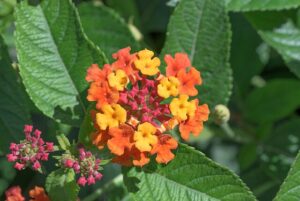
- Unique Attributes: Known for its bright, multicolored clusters of flowers in shades of yellow, orange, pink, and purple, lantana attracts butterflies and is drought-tolerant once established.
- Time to Plant: Plant in spring after the last frost or early fall when temperatures begin to cool.
Aromatic Aster (Symphyotrichum oblongifolium)
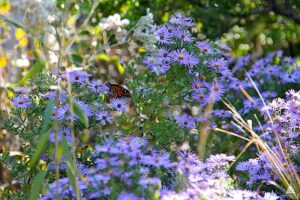
- Unique Attributes: This perennial features fragrant, purple-blue flowers that bloom in late summer to fall and attract pollinators like bees and butterflies.
- Time to Plant: Plant in spring or early fall for best establishment.
Copper Canyon Daisy (Tagetes lemmonii)
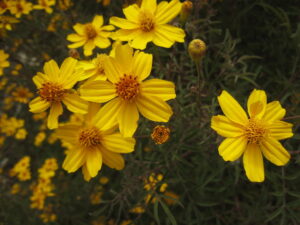
- Unique Attributes: Distinguished by its finely divided foliage and bright yellow, daisy-like flowers, this plant exudes a strong, citrus-like fragrance when crushed.
- Time to Plant: Plant in spring after the last frost or in early fall to establish before winter.
Coral Bells (Heuchera spp.)
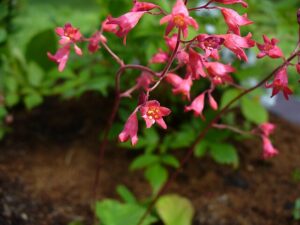
- Unique Attributes: Grown primarily for their colorful foliage in shades of green, purple, red, and silver, coral bells also produce delicate flower spikes that attract hummingbirds.
- Time to Plant: Plant in early spring or fall for the best root establishment.
Crossvine (Bignonia capreolata)
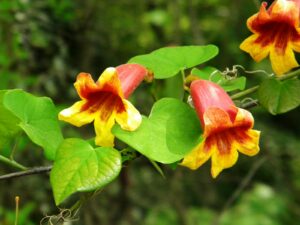
- Unique Attributes: A vigorous, evergreen climber that produces large, trumpet-shaped flowers in shades of orange, yellow, or red. It’s known for attracting hummingbirds.
- Time to Plant: Plant in spring or early fall to give it time to establish before blooming.
For more resources on various types of flowers, we will leave you with some great links to other sites. Although we have curated a few hand picked flowers that are proven to grow well in Texas, you may find these more in-depth sources to be helpful as well.
Lady Bird Johnson Wildflower Center
EPIC Gardening (Perennial Guide)
